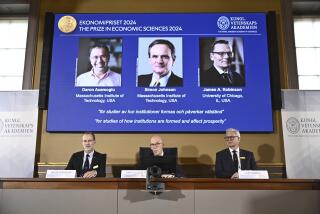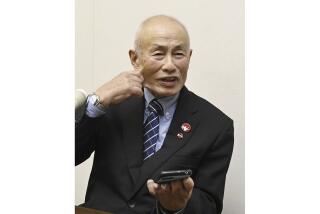Nobel’s Modest Legacy : For Southland’s Laureates, the Thrill of Winning Comes in Small Ways
What becomes a Nobel laureate most? A new Porsche? A sailing yacht? How about a trip around the world?
Not quite.
A more modest and unusual legacy has awaited Southern California’s Nobel Prize winners--a small fraternity that grew by one this week when USC chemistry professor George A. Olah claimed the world’s top intellectual honor.
For men of such achievement, the thrill of the award comes in small ways--like acquiring that new parking space closer to the lab, buying a long-enduring wife a new watch or putting away some money for the kids.
When Caltech chemist Rudolph Marcus returned to work after his 1992 Nobel, one would have hardly known his life had changed. Marcus remained so remarkably focused on his study of energy storage that colleagues quipped that he “must have spent his million dollars on a new sweater.”
One colleague said he spotted Marcus one day not long after his return from Stockholm parking his car in a space, newly marked with his name and just outside his office. “He said to me ‘Well, the Nobel Prize has to be worth something,’ ” recalled Stephen Mayo, an assistant professor of biology.
Indeed, Marcus still walks to work most days from his home near Caltech’s Pasadena campus. He still drives a clunky 1978 Oldsmobile and reports proudly that his wife, Laura, met King Carl Gustav XVI at the Royal Swedish Academy of Sciences she was wearing a dress that a friend sewed for her.
Most of his $1.2 million in winnings sits in investments or in the bank. (He notes, in fact, that the prize had lost 20% of its value by the time he received his check because of a rapid devaluation of the Swedish krona .)
The flood of speaking requests and other offers has been so heavy that Marcus has had to take on an extra secretary half-time just to handle them all.
“It’s best if one doesn’t think too much about prizes and things,” Marcus said. “That puts the focus in the wrong place, which should be on your work . . . on a particular problem and how you should solve it.”
If he has made one resolution in his two years since winning the prize, Marcus said it is to get better at saying “no.”
“The big question you have to answer is whether you want to turn into a traveling salesman, or whether to use your time to produce something valuable and something new,” Marcus said. “I like to answer questions.”
UCLA’s Donald Cram shares much the same philosophy and, for years, has loathed the tendency of some Nobel prize winners to leave their scientific roots and wander off in other directions. He calls Linus Pauling, a onetime hero, a “fallen angel” for leaving the work that brought him a Nobel Prize in chemistry to promote, among other things, world peace and the curative values of Vitamin C.
“I have looked on the Nobel Prize as an opportunity to do more of what I enjoy and what I am good at and that is science,” said Cram, who received the honor in 1987 for his work in chemistry. “That is the central core of my life. It’s not a youthful fashion. It is something that has stayed around.”
The 75-year-old scientist--whose colorful bow ties and guitar concerts are legend at UCLA--said that most of the time it is easy to remain true to that central core.
When a Korean newspaper association, for instance, wrote to him with a novel proposal, Cram knew he was out of his ken. The association wanted him to join a team of Nobel Prize winners to rewrite the Ten Commandments.
“Something just didn’t fit there,” said Cram, laughing.
As for his financial prize, Cram was not as big a winner as those in recent years. His $180,000 in winnings reflect the fact he shared the chemistry award with two others and that the bequest of Alfred Nobel has experienced a remarkable increase in value in recent years.
Not that Cram hasn’t put the money to good use. The professor this year bought a home overlooking Orange County’s Monarch Bay, in part with his prize money. From there, he can see as far as the San Onofre beaches and the beloved waves where he has surfed for 40 years.
But Cram insists that it is the non-material rewards that have been the most valuable to him. He doesn’t have to teach classes anymore. He can attract grants now without the old strain and lure colleagues from all over the world to join his research team.
“It has extended my scientific life,” Cram said. And, most happily for him, Cram said the award brought long overdue recognition to his wife and longtime collaborator, Jane.
He used the award money to act on a long-delayed urge to buy Jane a gold watch, too. Although Cram laughingly admits that even on that extravagance, he sought out the best buy that he could.
“I was raised in Vermont,” he said. “Money doesn’t circulate very frequently in New England and particularly in Vermont.”
The area’s third and senior surviving laureate is 1983 physics prize winner William A. Fowler who, like Marcus, lives within walking distance of the Caltech campus where he worked for many years.
*
Now a professor emeritus, he gave two-thirds of his $90,000 award to two daughters and put the rest into the bank and investments.
He had already retired by the time the prize came and a bad back and other ailments have long since led him to give up the lecture circuit. But even Fowler likes to keep a hand in the old game.
Fowler sightings are still a remarkable event on campus and his Nobel status allows him to keep on an assistant on campus who comes to his Pasadena home each afternoon to retrieve letters to be typed and to deliver the latest research papers.
The 83-year old notes wistfully that a whole new field of nuclear study has opened up recently and that he still has a few ideas floating around. “I’m still hoping to get a second one,” he sighed. “You never know.”







